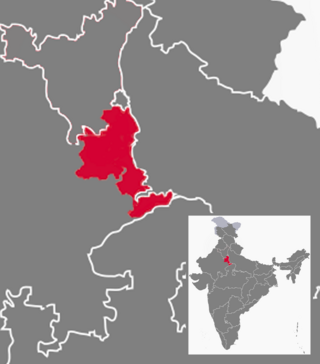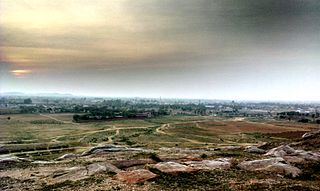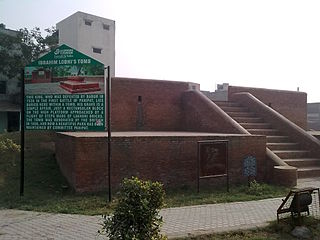
Lodi Gardens is a city park situated in New Delhi, India. Spread over 90 acres (360,000 m2), it contains Mohammed Shah's Tomb, the Tomb of Sikandar Lodi, the Shisha Gumbad and the Bara Gumbad, architectural works of the 15th century by Lodis - who ruled parts of northern India and Punjab and Khyber Pakhtunkhwa province of modern-day Pakistan, from 1451 to 1526. The site is now protected by the Archaeological Survey of India (ASI).

The Lodi dynasty was a dynasty that ruled the Delhi Sultanate from 1451 to 1526. It was the fifth and final dynasty of the Delhi Sultanate, and was founded by Bahlul Khan Lodi when he replaced the Sayyid dynasty.

Mewat is a historical and cultural region which encompasses parts of the modern-day states of Haryana, Rajasthan, and Uttar Pradesh in north-western India.

Khanzada Mirza Khan Abdul Rahim, popularly known as simply Rahim and titled Khan-i-Khanan, was a poet who lived in India during the rule of Mughal emperor Akbar, who was Rahim's mentor. He was one of the nine important ministers (dewan) in Akbar's court, known as the Navaratnas. Rahim was known for his Hindustani dohe (couplets) and his books on astrology.

Gurgaon district, officially known as Gurugram district, is one of the 22 districts of Haryana in northern India. The city of Gurgaon is the administrative headquarters of the district. The population is 1,514,432. It is one of the southern districts of Haryana. On its north, it is bounded by the district of Jhajjar and the Union Territory of Delhi. Faridabad district lies to its east. To its south lie the districts of Palwal and Nuh. To the west lies Rewari district.

Alwar is a district in the state of Rajasthan in northern India, whose district headquarters is Alwar city. The district covers 8,380 km2. It is bound on the north by Rewari district of Haryana, on the east by Bharatpur district of Rajasthan and Nuh district of Haryana, on the south by Dausa district, and on the west by Jaipur district.

Nuh district is one of the 22 districts in the Indian state of Haryana. There are four sub-divisions in this district: Nuh, Ferozepur Jhirka, Punahana, and Taoru. The district is known for having the largest Muslim population in Haryana.
Ferozepur Jhirka is a town in the Nuh district of the Indian state of Haryana. It was founded by the ruler of Mewat State, Khanzada Feroz Khan.

Narnaul is a city, a Municipal Council, and location of headquarters of the Mahendragarh district in the Indian state of Haryana. It is located in the National Capital Region of India.
Nuh(Hindi/Urdu pronunciation: [nũːɦ]) is a city in the Indian state of Haryana. It is the administrative headquarter of the Nuh sub-division in Nuh district of Haryana and lies within in the National Capital Region of India.

Taoru or Tauru is a town, near Nuh city in Nuh district in the Indian state of Haryana.
Tijara is a city and a municipality in Khairthal-Tijara district of the Indian state of Rajasthan. Tijara comes under the NCR area and is situated 55 km to the northeast of Alwar. The nearest railway station to Tijara is Khairthal. Bhiwadi is a census town in Tijara. It is the biggest industrial area of Rajasthan and part of the historical Ahirwal Mewat region. Tijara is dominated by Yadav and Meo community. The new political map has not erased the ancient Ahirwal-Mewat boundaries. Ahirwal was a post-Mughal principality ruled by Ahirs or Yadavs.

Tosham is a town and a Gram Panchayat on the foot of Tosham Hill range in Bhiwani district in the Indian state of Haryana. It has been awarded the title of "Adarsh Village". It is situated in the foothill of Tosham hill range of Aravali Mountain Range. The hill has several historic places, such as forts, carvings, paintings, temples, sacred ponds, dating as far back 1800 years. It is a rural area.

Kotla Mubarakpur, a medieval famous urban village, is a market place with residential colony in South central part of New Delhi. Kotla Mubarakpur classified by the Delhi Development Authority (D.D.A.) as an Urban Village which is dominated by Baisla gotra of Gurjars, it is situated within touching distance of South Extension. Defence Colony lies to its east. Nearest Delhi Metro stations are South Extension, Dilli Haat - INA and Lajpat Nagar. Its history can be traced to the prominent tomb of Muizud Din Mubarak Shah, son of Khizr Khan of the Sayyid dynasty of the fifteenth century Delhi Sultanate rule in India, and its adjoining mosque. There are several other tombs of Lodi Dynasty period such as the Darya Khan's tomb, Kale Khan ka Gumbad, Bare Khan ka Gumbad, Chote Khan Ka Gumbad and Bhure Khan ka Gumbad, and also a Baoli.

Haryana is a state in India. The state houses several sites from the Indus Valley Civilization, which was a cradle of civilization. In the Mahabharata, Haryana is mentioned as Bahudanayak Region.

Surajkund is an ancient reservoir of the 10th century located on Southern Delhi Ridge of Aravalli range in Faridabad city of Haryana state about 8 km from South Delhi. Surajkund is an artificial Kund built in the backdrop of the Aravalli hills with an amphitheatre shaped embankment constructed in semicircular form. It is said to have been built by the king Surajpal of the Tomara Rajputs in the 10th century. Tomar, a younger son of Anangpal Tomar – the Rajput ruler of Delhi, was a sun worshipper and he had therefore built a Sun temple on its western bank. Surajkund is known for its annual fair "Surajkund International Craft Mela", 2015 edition of this fair was visited by 1.2 million visitors including 160,000 foreigners with more than 20 countries participating in it.

Damda reservoir in Sohna, near Gurugram city in Gurugram district in the Indian state of Haryana. Damdama Lake is a small lake in Haryana and was formed when a stone and earthen dam constructed by the British was commissioned for rain water harvesting in 1947. The lake, held by an embankment, is fed mainly by monsoon rain pouring into a trough at the base of the Aravali hills. The lake greets visitors with a water level down to 20 ft (6.1 m). During monsoon the water level reaches up to 50 ft (15 m) - 70 ft (21 m).
Tourism in Haryana relates to tourism in the state of Haryana, India. There are 21 tourism hubs created by Haryana Tourism Corporation (HTC), which are located in Ambala, Bhiwani Faridabad, Fatehabad, Gurgaon, Hisar, Jhajjar, Jind, Kaithal, Karnal, Kurukshetra, Panchkula, Sirsa, Sonipat, Panipat, Rewari, Rohtak, Yamunanagar, Palwal and Mahendergarh.

The Tomb of Ibrahim Lodi in Panipat is the tomb of Ibrahim Lodi, Sultan of the Lodi dynasty.
The 2023 Haryana riots commonly referred to as the Nuh violence were a series of clashes in northern India that originated in the state of Haryana and have subsequently spread to nearby regions. On 31 July 2023, communal violence erupted in the Nuh district of Haryana between Muslims and Hindus during an annual Brajmandal Yatra pilgrimage organised by the Vishva Hindu Parishad (VHP), a Hindu nationalist organization. By the evening of the same day, fresh incidents of communal violence were reported from Gurugram and Sohna. As of 3 August 2023, the situation has resulted in at least seven fatalities and over 200 reported injuries.


















